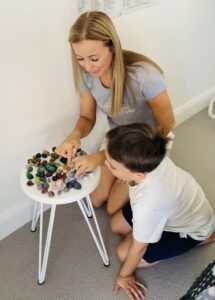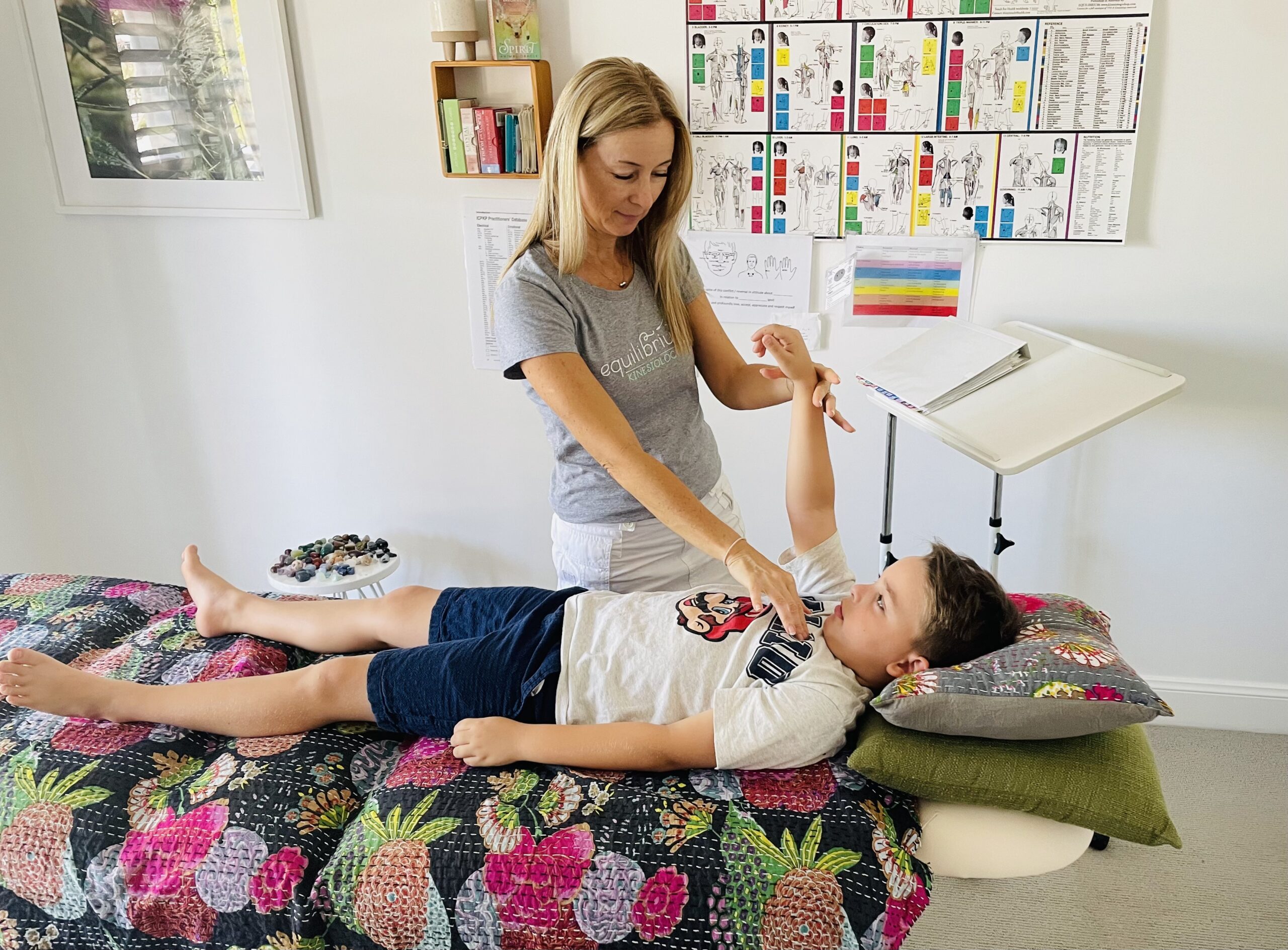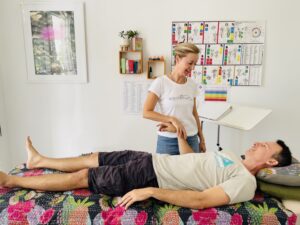Frequently asked questions…
Are online balances available?
Yes. Online balances are available for those that prefer or need them. Just let me know at the time of booking if you’d prefer your balance to be online. I generally use Zoom as the platform but can use Messenger, FaceTime or phone if preferred.
Online kinesiology balances are beneficial for those with mobility issues who find it difficult getting out to access services, as well as anyone who finds coming to a clinic stressful (e.g. anxiety, autism etc). It’s also very convenient and time efficient if you live far away or have a busy schedule and difficulty coming to clinic in person.
An online balance is $140 per session.
How does an online kinesiology balance work?
An online kinesiology balance looks and feels much the same as one in clinic. Instead of being face to face in clinic with me, you’ll be in the comfort of your own home and seeing and talking to me on your phone/iPad/computer screen. Phone is fine however I do recommend some form of video link (e.g. Zoom) so we can see each other. Visual contact will help you to follow the session and enable you to see the any cards, essences or crystals that may be relevant. I will text or email these to you if required.
With your permission I will surrogate for you during the session. I will be muscle testing for you and doing the corrections on myself which will flow through to you.
How can you muscle test me online?
I’ll use a technique called ‘surrogating’ whereby, with your permission, I’ll surrogate for you and muscle test on your behalf. This may sound odd but it’s a common technique in the kinesiology world and one I use often, even when you’re in clinic with me. It’s a safe technique and one that allows you to keep receiving the benefits of kinesiology from a distance.
What is distance or remote healing?
This is similar to an online balance except you don’t need to be present, or even online or on the phone for your session.
Distance/remote kinesiology balances are particularly beneficial for those who have a busy schedule, are time poor, and find it difficult fitting a balance into their day. You simply send me the relevant information about the issue/s and what you’re aiming to achieve and I do the kinesiology balance for you using a surrogating technique. A distance/remote balance has the convenience of you being able to go about your usual day, without having to take time out of it, and still receive all the benefits of a kinesiology balance. I’ll email you the notes and details of what came up for your information.
A distance balance is the same cost as an online or face to face balance, $140 per session.
How does a remote or distance kinesiology balance work?
With your permission I will surrogate for you for the session. I will muscle test for you and do the corrections on myself which will flow through to you. You can go about your day as usual and the balance will energetically flow to you like magic. I know that sounds odd, but many clients attest that remote and distance healing is still as beneficial as in person and they definitely feel the difference.
How can you muscle test me remotely?
I’ll use a technique called ‘surrogating’ whereby, with your permission, I’ll surrogate for you and muscle test on your behalf. This is a common technique in the kinesiology world and one I use often, even when you’re in clinic with me. It’s a safe technique and one that allows you to keep receiving the benefits of kinesiology from a distance.
Is the clinic accessible?
There are 8 stairs with handrail to access the clinic. If these are not manageable for you, we can arrange an online or distance session for you.
Is kinesiology safe or beneficial for children?
Yes, I work with children and babies of all ages – even those in the womb! If your child is very young I may use you to assist with the balance via a technique called ‘surrogating’ whereby you or I will surrogate for your child and muscle test on their behalf. It is a safe and effective way of ensuring your child can receive the benefits of kinesiology as well.
Children can benefit from kinesiology in all the ways adults can. It’s highly beneficial for emotional problems such as anxiety, trauma and stress. It can also be particularly helpful if they’re having difficulty at school, with learning, concentration, comprehension, memory or any other aspect of school work, as well as social issues, anxiety or bullying. There are various techniques and exercises they can be taught and used to help them achieve their potential both in and out of the classroom.
Balances for children are $140 per session.
Do you balance animals as well?
Yes, I do balance animals. I do this via distance/remote healing using a surrogating technique. The animal doesn’t need to be present for the session – you can either come in and surrogate for them, or you can send me a photo of them along with the information (i.e. what is going and what you’d like to change/work on) and I’ll do a distance/remote session for them using a surrogating technique. They’ll get all the benefits and I’ll email you the notes and details of what came up for your information and reference.
Animal balances are $140 per session.
Before your balance
I recommend you are well hydrated as this facilitates muscle testing.
If your balance is face to face in clinic I’d suggest you wear shorts or pants as you’ll be lying on a massage table and there may be some leg movements involved.
Other than that, just come along with an open mind and willingness to explore the process.
During your balance
At your initial consultation I’ll take a client history. This will include collection of standard information such as contact details, history of the issue you’re coming to see me for, current medications or supplements etc. I may also ask about past significant events, family and other relationships etc. The aim of this is to provide as much information about you, where you’re at it in life, how you got there and where you’re wanting to go. This helps identify what to work on to get you to where you want to be.
After the client history we’ll start the kinesiology balance. You remain fully clothed throughout and have the choice of sitting, standing or lying. Most clients prefer to lie on the massage table.
The ‘balance’ is painless and involves me moving various muscles and/or using pressure points and touch. It may seem a bit odd and unlike anything you may have experienced before but I encourage you to relax and go with it.
Do I have to lay down?
No. We can do the balance with you sitting, standing or lying – whichever you prefer. Most people lay on the massage table. The table is very functional and can elevate so you’re not completely lying down. This is great for pregnant women. It can also elevate and bend through the leg area which is perfect for those with lower back issues. Or it can do both. There are a range of options so we can tailor the session and positioning to suit your needs. It’s also a very comfy table.
After you balance
After the balance I’ll do a further assessment and we’ll discuss any changes. I may also suggest some home reinforcement (homework) for you to consider.
How you feel afterwards will vary as each person is different. Most people leave saying they feel ‘lighter’. You may however feel a bit tired as, while you’ve been having nice relax, there has been a lot going on in your energy system, shifting and moving, which can make you feel a bit tired. That’s completely normal. A good sleep or nap will remedy it. It can take a few days (and really good sleeps) for your body to take up and process the changes. If there was physical pain usually you’ll leave with reduced or no pain. If it was an emotional issue you may feel ‘lighter’ or more at peace. Often these changes will become more noticeable and prominent as your body fully processes the balance.
On rare occasions a client may experience a headache or an ‘off’ feeling, most likely due to toxins being stirred up and leaving your body. It’s important to drink plenty of water as this helps eliminate toxins and assists your body with processing and recovery.
Kinesiology 101
Kinesiology (pronounced kin-easy-ology) is a holistic natural therapy. It combines theories and knowledge from various modalities such as traditional Chinese medicine, physiotherapy, chiropractic, naturopathy and counselling.
What makes kinesiology unique is that it uses muscle monitoring/biofeedback to tailor each treatment specifically to you. A fundamental premise of kinesiology is that the body has innate healing energy and is at all times doing its best to care for and heal itself – sometimes it just needs a bit of help to achieve this.
I use painless manual muscle monitoring techniques to evaluate your body’s systems in relation to stress. The muscle response directs me to the root cause of the problem as well as to the correction/balance needed to assist resolving it.
‘Corrections/balances’ are generally a combination of western techniques and eastern wisdom i.e. it could be stimulation of pressure points, administering a flower essence or modifications to diet. The correction will assist in re-establishing effective pathways to bring the body, mind and energy into balance and harmony, thus facilitating physical, emotional and mental health.
What is manual muscle monitoring?
Manual muscle monitoring is done by the Kinesiologist placing a muscle into a specific position and applying light pressure. The muscle response provides an indication as to whether or not the body is holding stress in relation to the muscle, energy meridian or issue.
It is a simple and painless process and is a Kinesiologist’s main assessment tool.
What do you mean by stress?
Stress can be structural, chemical (nutrition), electrical (brain integration) or emotional in nature. When something is causing stress to the body the muscles will respond accordingly when monitored.
Traditional Chinese medicine principles state that ‘stress’ blocks the flow of energy or “Qi” (Chi) in and around the body. This subsequently affects the functioning of organs, glands, muscles and systems of the body which in turn affects overall health and wellbeing.
Stress may be conscious or unconscious and is often hidden under several layers. Dramatic changes can be seen once the causal layer is dealt with and resolved.
Kinesiology enables us to deal with multiple layers of stress to uncover and release the core layer, thereby freeing it or giving you and your body ways to manage and cope with it.
What can Kinesiology help with?
Kinesiology can assist in bringing the physical, mental, emotional, spiritual and social aspects of your being into alignment and balance. It can shift and clear old cell memories, patterns and emotional blocks before they manifest into illness or physical ailment.
It can assist with an incredibly broad range of issues such as:
· Anxiety and depression
· Managing and coping with stress
· Sleep, improving energy levels and motivation
· Self-esteem
· Learning difficulties, focus, concentration and co-ordination
· Pain relief and injury recovery
· Specific emotional issues – phobias, fear and abuse
· Weight loss
· Headaches
· Food sensitivities and allergies
· Hormone imbalances and fertility
· General well-being and health
Is kinesiology a form of medical treatment?
No. I don’t diagnose, treat or work with named diseases. You may have a medical issue however I will simply balance your body to put it in the best possible frame to utilise its own healing abilities to assist with that issue.
While Kinesiology can help with a wide range of health issues but you don’t need to be sick to benefit from it. It can assist you to make positive changes and improve your overall health and wellbeing in many different ways.
Is it safe?
Yes, kinesiology is a recognised natural therapy. It is completely safe with no negative side effects. It is fully guided by your muscles’ responses and is done in complete privacy.
How many appointments will I need?
Depending on your issue you may achieve the results you’re after in one session however I find it’s beneficial to have 2-3 in order to stabilise and reinforce changes.
Kinesiology is generally fast and effective with lasting results.
How long does a balance/session take?
Consultations are generally 45 minutes to an hour in length. As we’re guided by your body and what it needs, some sessions may be slightly shorter and some slightly longer. If you have a time constraint, please let me know at the start of the session and I’ll make sure to get you out in time.
What do I wear for my appointment?
To be comfortable I’d recommend wearing shorts or pants which allow flexible movement. You’ll likely be lying on a massage table and there may be some leg movements involved.
Do I need to bring anything with me?
No, you don’t need to bring anything specific with you.
If you’re on medication or supplements you may wish to bring them with you and we can muscle test for compatibility with your body.
What is the difference between the various types of Kinesiology?
One major difference between the Kinesiology I practice and some others is the length of training. The Professional Kinesiology Practice (PKP) training I’ve completed is 3-4 years in length and involves many hours of study and homework with hands-on experience. Some kinesiology courses run over just a few months, or even weekends. Whilst these short courses are a great introduction and complement other forms of therapy, PKP Kinesiology is a complete therapy in itself.
Another difference is that PKP practitoners incorporate emotions into balances as clearing the related emotion can help the corrections hold much better and longer.







